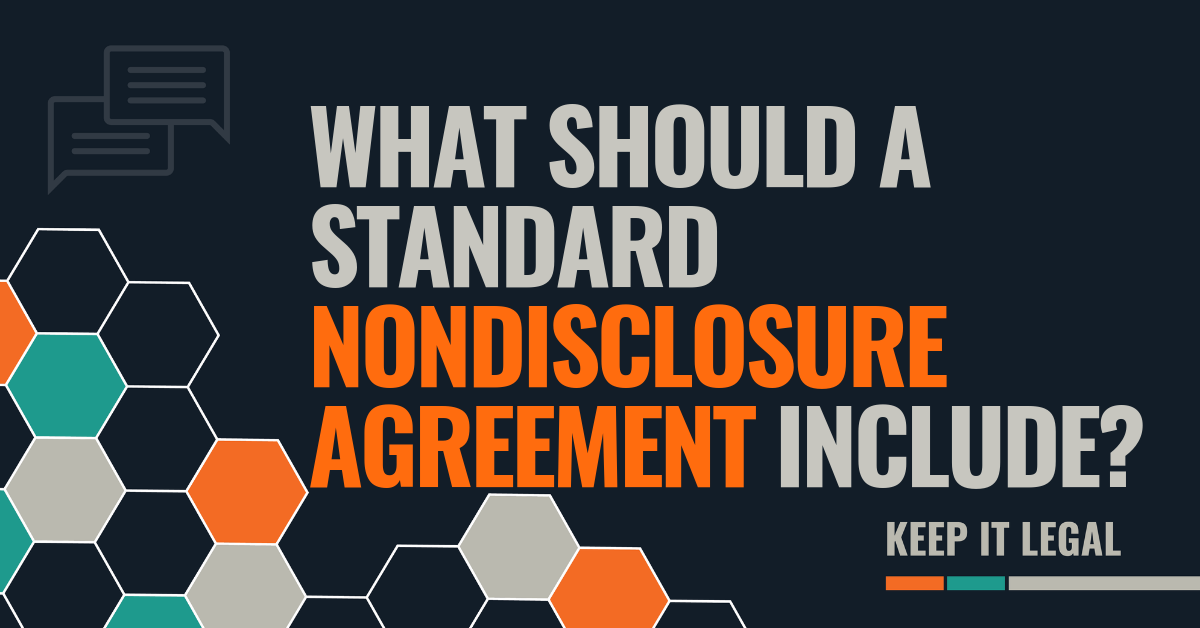There may be no more critical tool for new companies and inventors than a solid nondisclosure agreement. Generally speaking, standard nondisclosure agreements allow a company to share secret information with other parties while legally prohibiting those parties from spreading the information to a wider audience.
Nondisclosure agreements (also known as NDAs) can be used for a variety of purposes, including dissemination of financial information, marketing plans, new technologies, or confidential business processes.
NDAs are especially important when a company or entrepreneur is trying to protect their trade secrets. Legally speaking, trade secrets consist of any information that: (1) derives independent economic value from not being known to the public generally; and (2) is subject to reasonable efforts to maintain secrecy. Having outsiders sign a standard nondisclosure agreement is a near necessity in order to protect trade secrets.
So, what makes a nondisclosure agreement strong? I’ve compiled some of the most crucial clauses that should be included in any good NDA.
Define the Parties
This may sound like an obvious point – don’t all agreements spell out the parties involved? For the most part, yes. In nondisclosure agreements, though, the parties need to be defined with great clarity.
Let’s say Company A enters into a standard nondisclosure agreement allowing it to share confidential information with Company B. The term “Company B” needs to be defined with precision so that Company A knows the group of individuals that may access its information. Does Company B include all of its employees or only its executives? Are independent contractors included in that definition? How about outside vendors? These decisions need to be spelled out within the NDA so that the parties know exactly who can – and cannot – view the information.
Specify the “Confidential Information”
Standard nondisclosure agreements are clearly intended to protect “confidential information,” but the meaning of that term will vary in different situations. Returning to our prior example, if Company A shares a design drawing with Company B, the term might be defined as follows:
Confidential information shall mean and include any and all copies of the design drawing, including drafts, renderings, photocopies, scans, discarded versions, and the final product, regardless of whether any such drafts are in electronic or physical form and regardless of where and how they are stored or transmitted.
Not surprisingly, these clauses could (and, in many cases, should) be lengthy and complex. The key is to clearly articulate exactly what is being protected so that there’s no question regarding what information (if anything) can be shared with outsiders.
Clarify Whether the Nondisclosure Agreement Is Mutual or Unilateral
It’s also critical to specify whether the obligation of confidentiality extends to both parties or just one. If Company A and Company B are both sharing confidential information with the other, the agreement needs to be mutual. But if Company A is the only party sharing such information, all confidentiality obligations should fall on Company B.
Set the Duration
Many parties forget to negotiate the term of the NDA – in other words, how long the obligation of confidentiality is to last. This is another factor that will vary from case to case.
For example, if the confidential information that’s being exchanged is a marketing plan, the contract term should be at least as long as it will take to execute that plan. In contrast, if the confidential information relates to a complicated business process that the discloser intends to follow for the foreseeable future, the term should last for a number of years.
Lay Out Terms in the Event of a Breach of the Agreement
A solid nondisclosure agreement should spell out exactly what happens if the party receiving the confidential information shares that information with others (i.e., breaches the obligation of confidentiality).
In many situations, monetary damages will not be sufficient because the disclosing party really wanted their secrets to remain secret. Thus, the typical remedies clause (i.e., how a breach will be addressed legally) in a standard nondisclosure agreement is one for “injunctive relief.” Basically, this allows the disclosing party to ask a court to immediately stop the dissemination of confidential information through an injunction. While seeking this sort of relief can be burdensome without such a clause, the process will be more efficient if the right contract language is in place.
A Standard Nondisclosure Agreement That’s Up to Your High Standards
These days, many people are tempted to just download any old NDA off the internet and put it into use for their business. This is a risky proposition, however, as many of those “template” agreements omit some of these critical clauses. If you have questions about developing a solid nondisclosure agreement, please feel free to contact me today.


